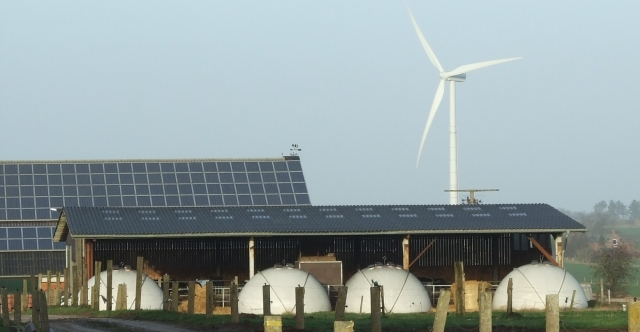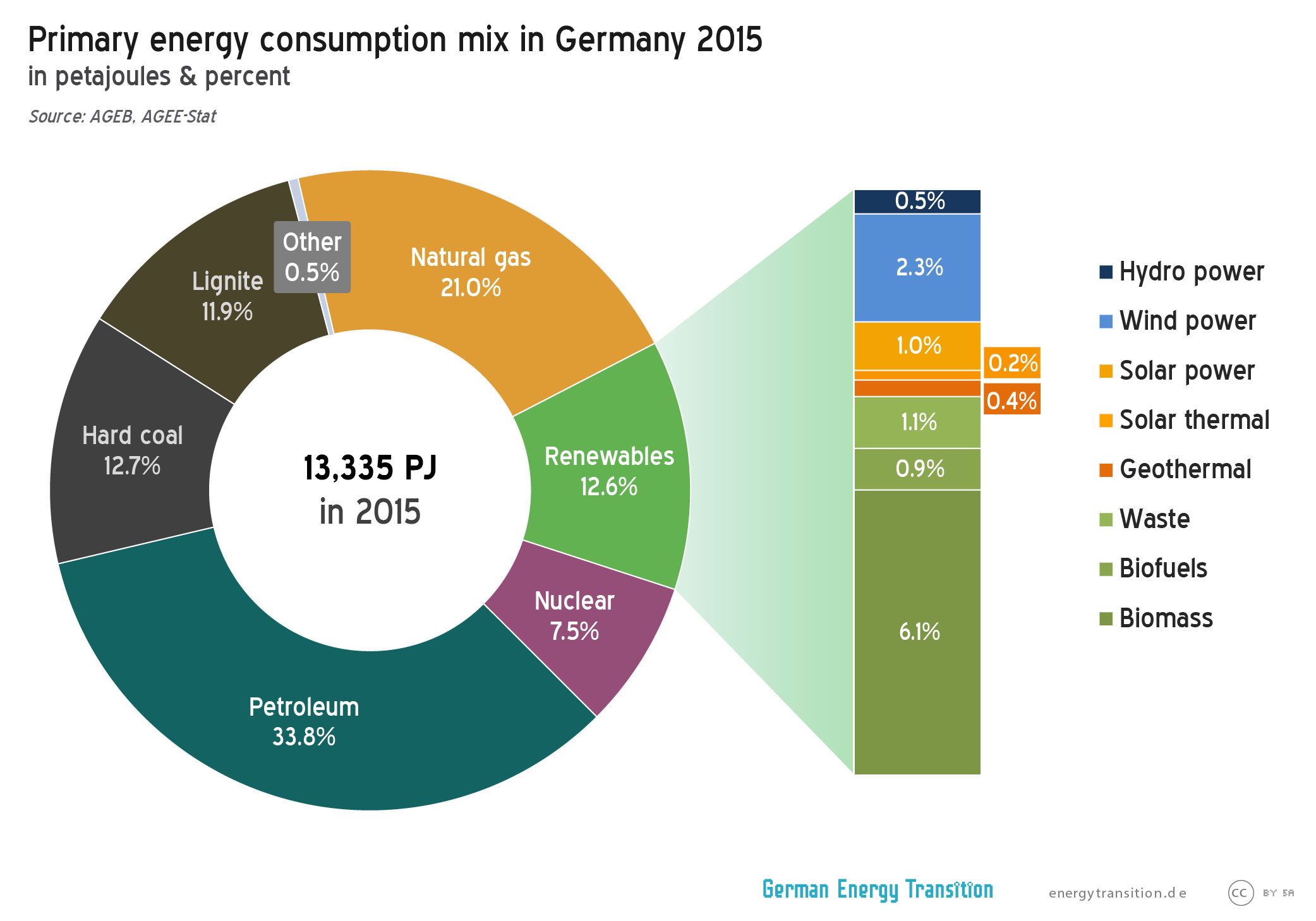Last week, we discussed changes in the German power sector in 2015, particularly how Germany is scheduled to overshoot its target for green electricity. Today, we focus on all energy (power, heat, and motor fuels). To our surprise, the target of 18 percent renewable energy by 2020 is not out of reach. Craig Morris explains.

The progress in 2015 – an increase of possibly 1.8 percentage points – would be the largest in history if our calculation proves accurate. (Photo by Florian Gerlach, modified, CC BY-SA 3.0)
In 2015, German energy consumption rose by 1.3 percent according to preliminary figures published just before Christmas by the AGEB, an independent group of economists and the sector experts (press release). The organization attributes this increase to three main factors: slightly colder weather, which increased demand for heat; 1.8 percent economic growth; and more than one percent population growth (more than 1 million refugees came to Germany last year). Adjusted for the weather affect alone, energy consumption was down by 1.5-2.0 percent.
Consumption of natural gas was up by 0.6 percentage points primarily because of greater demand for heat (its share fell in the power sector). Likewise, the share of nuclear fell by the same amount because a nuclear reactor was switched off. Otherwise, coal consumption remained practically unchanged, as did petroleum demand. But the share of renewables increased by 1.1 percentage points to reach 12.6 percent.

Germany has another five years to reach 18 percent renewable energy by 2020. From 2011-2015, the increase was a very modest 1.8 percentage points. Adding on that amount for the five remaining years up to 2020 only brings us to 14.4 percent, far short of the target.
But there’s a problem with this calculation – it’s based on primary energy, whereas the EU targets for renewable energy are based on final energy. (Primary energy is a lump of coal or a tank of gas; final energy is the electricity from that coal or the motive energy from that gasoline.) When we adjust for this difference, we find a much different outcome.

In terms of final energy, the share of renewables grew from 11.9 percent in 2011 to 15.3 percent in 2015, an increase of 3.4 percentage points over five years. At that rate, Germany would overshoot its 2020 target to reach 18.7 percent renewables.
However, no official estimate has yet been produced for final energy. The calculation is abstract; we know how much electricity was generated, but the calculation of final energy for all the heating systems around the country and for motor fuel used in the country’s more than 40 million vehicles is based on certain assumptions (such as the average efficiency of heating systems and vehicle gas mileage). It will be some time before that number is published, but as long as it does not drop below 15.0 percent, Germany will remain roughly on target for 2020.
Still, some caveats remain. The progress in 2015 – an increase of possibly 1.8 percentage points – would be the largest in history if our calculation proves accurate. (To produce our estimate, we merely took the ratio of final to primary energy from 2012-2014, in which no nuclear plants were shut down – any such change would affect the ratio, which we found to be fairly close to 2:3 for those years). It is not completely unprecedented, however. In 2007, the share rose by 1.6 percentage points, mainly because bioenergy grew strongly that year; in addition to growth in the power and heat sectors, biofuels were at at 47 TWh that year (they have since fallen to around 35 TWh). The growth in 2015 clearly came from wind power in the power sector, and that is the only renewable energy source that will continue to grow by 2020. Solar now fails to reach the annual growth target, and the government has also slammed the brakes on bioenergy.
The good news is that, thanks to a bumper year in 2015, the 2020 final energy target has moved back into reach. And with five years left, the country still has time to tweak policies so that the target is reached. More electric mobility would provide space for renewable power to grow in the transport sector, and electricity could be used as a heat source when renewables push conventional power plants down to low production levels. Unfortunately, not much is happening with either option. It will be a close race.
Craig Morris (@PPchef) is the lead author of German Energy Transition. He directs Petite Planète and writes every workday for Renewables International.
The circle graph with the expanded renewables is effective. It’s clear that the fat petrol-colored band at 33.8% is a prime target for slimming. The EU website referred to also says that by 2020 all EU countries should be using using at least 10% biofuels for transportation – this may or may not be a good idea, but must imply something like a doubling of the 0.9% biofuel contribution shown for 2015 (?)
@ S.Herb:
The EU target for biofuel was reduced from 10% to 7% as far as I remember, check this out.
As well new biofuel sources are only supported if they generate the fuel from waste, not from edible crops or from agricultural land.
The EU wants to see more synthetic(bio-) fuel made from straw, bio-methane, waste timber and so on. If power-to-gas is included in the new biofuel demands I don’t know but I’d say so.
The neighbors are supporting the German Energiewende as well:
http://www.energinet.dk/EN/El/Nyheder/Sider/Dansk-vindstroem-slaar-igen-rekord-42-procent.aspx
If Denmark can see the first day without conventional power plant (forgive me this now outdated term) then it won’t take long for Northern Germany as well.
Norway’s grid authorities are scratching their heads if they should support more interconnectors because then the others would get all the cheap and green power …
http://af.reuters.com/article/commoditiesNews/idAFL8N14Y1OW20160114
Germany has already the cheapest power in Europe, only Scandinavia (Norway!) beats them:
http://www.pv-magazine.com/news/details/beitrag/germany-2016–expanding-renewables–stagnating-decarbonisation–increasing-power-prices_100022722/#axzz3xK5IHbFy
Yesterday the futures at the German power change traded for the first time ever below € 30.-/MWh for 2018 and 2019 – that’s for peak load!
http://www.eex.com/de/marktdaten/strom/futures/phelix-futures#!/2016/01/15
Again: renewables are included in primary energies. But that is wrong. For what is the primary energy for wind or solar or hydro? It definitely is not kWh electricity, for that is not primary energy!
Bio-based renewables have a primary energy factor. But is that used instead of kWh electricity?
“Primary” Energy may be ok for conventionals, but it sells renewables short, underestimating their impact.
@Dr. Josef Pesch
Using primary energy might not sell renewables “short” all the time. Consider the latest UK energy trends download from the government of the UK. On page 43, table 5.1 it shows all the fuels used in electricity production represented in terms of Millions of tonnes of oil equivalent and how much electric in Terawatt hours. Here is a snapshot of the stats: Year 2014
Coal: 24.11 MTOE 100.71 TWh = 4.18 TWH per MTOE
Oil: 0.53 MTOE 1.88 TWH = 3.55 TWH per MTOE
Gas: 18.78 MTOE 100.93 TWH = 5.37 TWH per MTOE
Wind+
Solar 3.1 MTOE 36.07 TWH = 11.64 TWH per MTOE
Showing that you get an awful lot more electricity out from the calculated energy in. You can see from this if we get rid of fossil fuels and replace whatever part with solar and wind we will get a fast rise in energy output in terms of renewable share in final energy. This shows also how easy it should be to drop at least 30%+ primary energy from EU use with zero change of useful energy out or change in lifestyle or economy or whatever.
https://www.gov.uk/government/statistics/energy-trends-december-2015
For all your UK statistic needs!
Biomass makes up about half of the renewable energy mix in the diagram, but the carbon dioxide it produces upon combustion is indistinguishable from fossil fuel emissions. The CO2 from both sources is absorbed indiscriminately by the oceans and converted to carbonic acid, causing seawater pH levels to decline irreversibly. Since about one third of the atmospheric carbon dioxide is withdrawn from the natural carbon cycle in this manner, only two thirds will remain to nourish plant life. To the extent that thermal biomass usage contributes to ocean acidification, therefore, it cannot be ranked with solar and wind power as an alternative to fossil fuels. Biomass employed for energy production is likewise only partially replenished in the biosphere, since less atmospheric carbon is subsequently converted by photosynthesis to plant matter than had been originally emitted.